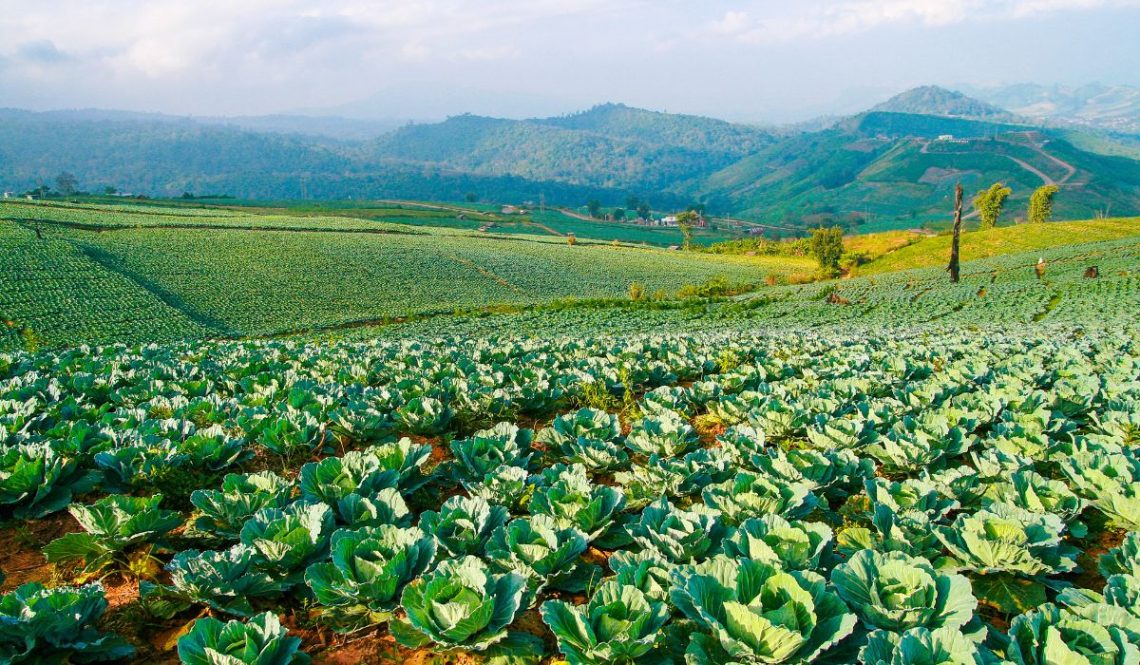
How To Start And Grow Cabbage Farming Business | SkillsAndTech
Do you want to grow cabbage and start a cabbage farming business? Here in this article, we list down the steps associated with creating a cabbage farming business plan.
Cabbage is a popular vegetable throughout the world. Because it has the adaptability to a wide range of climatic conditions and soil. In addition, ease of production and storage, and its food value gives another boost in production.
See Also: How To Start Cashew Farming Business
Another popular name is Khavhishi. The scientific name of cabbage is Brassica oleracea var. Capitata. Cabbage has an adventitious root system. Major cabbage-producing countries are China, India, Russia, Japan, South Korea, Ukraine, and Indonesia.
Cabbage consumption varies widely around the world. However, Russia has the highest annual per capita consumption at 20 kilograms. Cabbage is a very important winter crop in India.
See Also: How To Start Surgical Bandage Making Business
Therefore, the major cabbage-producing states are Uttar Pradesh, Orissa, Bihar, Assam, West Bengal, Maharashtra, and Karnataka. Furthermore, Cabbage is rich in minerals and vitamins A, B1, B2, and C. Cabbage cultivation is a profitable farming business and it assures quick returns.
Table of Contents
Economic Importance of Cabbage Farming
See Also: How To Start Cocoa Plantation Farming
Cabbage is an economically important vegetable in commercial trade. The consumption of cabbage includes eating the vegetable raw or steaming it. Pickling is one of the most popular ways of preserving cabbage, creating dishes such as sauerkraut and kimchi. Farmers generally produce cabbage as a cash crop. Cabbage has a strong footprint in domestic and international trade.
Cabbage is used raw in salads, such as coleslaw, as a cooked vegetable, or preserved in pickles or sauerkraut. Cabbage is 90% water and an excellent source of minerals, Vitamin A and C, and the B vitamins. Fresh cabbage juice has been shown to promote the rapid healing of peptic ulcers. Therefore, the fresh produce market, processors, restaurants, hawkers, retailers, and chain stores are the value chain distribution system for cabbage.
See Also: How To Start Tannery Business
Things To Consider in Cabbage Farming
- First of all, site selection plays an important role. Therefore, minimizing potential production problems is essential in cabbage farming.
- Field topography has a significant influence on crop production and management.
- Soils basically consist of decomposed mineral matter (sand, silt, and clay) and decomposed organic matter. Pay attention to land preparation.
- Water is the life-blood of vegetable production. Cabbage generally requires more water and more frequent irrigation than most other agronomic crops.
- In addition, choose the right variety. It is a make-or-break decision in cabbage farming.
- Alike any vegetable cabbage is also perishable in nature. To achieve profitability, a producer must have a well-thought-out production and marketing plan based on sound scientific and business principles.
- In conclusion, craft a proper business plan with marketing and financial calculations. Most startup vegetable operations generally fail due to the lack of market development or marketing skills.
Health Benefits Of Cabbage
See Also: How To Create Partnership Agreement In India
- Cabbage is very rich in fiber, the main health benefit of roughage. This helps the body retain water and it maintains the bulkiness of the food as it moves through the bowels.
- In addition, it is a good remedy for constipation and other digestion-related problems.
- Furthermore, cabbage is rich in sulfur. So, it helps fight infections in wounds and reduces the frequency and severity of ulcers.
- Cabbage is frequently recommended for people who want to lose weight in a healthy way.
- Cabbage is a rich source of beta-carotene. It improves eyesight and promotes good eye health.
- The presence of potassium in cabbage protects from high blood pressure.
- Cabbage acts as a good detoxifier too, meaning that it purifies the blood and removes toxins.
Best Varieties For Cabbage Farming
See Also: How To Start Designer Lace Making Business
You can group several types of cabbage into conical or sugarloaf-headed, ball-headed, and drum-headed based on the shape of the head and the savoy. Therefore, you can also classify them according to their color and growth cycle. The leaves may be green or purple and smooth or wrinkled. The savoy types are tolerant of cold conditions and they have deep-wrinkled dark green leaves.
Green cabbage: Varieties vary in their earliness and mature size. However, you can grow smaller varieties at close spacing.
Red Cabbage: It provides higher levels of vitamins A and C than other types of cabbage do, and its bright color is always beautiful on the plate.
See Also: How To Start Cricket Bat Making Business
Savoy cabbage: It produces a crisp heart and crinkled dark green outer leaves.
Pointed Cabbage: It develops conical instead of rounded heads. Its upright growth habit and tight outer leaves protect pointed cabbage from insects and the sun.
Napa Cabbage / Chinese Cabbage: It matures quickly and produces crisp, mild-flavored leaves.
Agro Climatic Condition For Cabbage Farming
See Also: How To Start A Gift Wrapping Business
Cabbage and leafy greens. It adopts a wide range of environmental conditions. Cabbage grows best in a relatively cool and humid climate. Therefore, you will find a poor yield and quality in summer. And it is also difficult to control insect pests. The optimum temperatures for growth and development are from 18 °C to 20 °C.
It is fairly resistant to frost and can survive temperatures as low as – 3 °C without damage. However, you can grow cabbage throughout the year in most regions. Organic cabbage always gives a better profit margin to the farmers.
See Also: How To Start A Watermelon Cultivation Business
Water requirements vary from 380 to 500 mm per crop, depending on the climate and length of the growing season. However, crop water uses increases during the growing period with a peak towards the end of the season. The susceptibility of different varieties to different climatic conditions is also an important point to consider.
Suitable Soil For Cabbage Cultivation
You can grow cabbage on a wide range of soils. However, it thrives on well-drained, moisture-retentive loamy soils well supplied with organic matter. It does not grow well in highly acidic soil.
See Also: How To Start Protein Shake Making Business
The ideal soil pH ranges from 5.5 to 6.5. It does not grow well in highly acidic soils. However, small quick growing cabbage varieties do well in sandy soils, while large and late-maturing varieties in heavy soils. Soils intended for cabbage growing should have good drainage.
Cabbage Cultivation Basic Steps
Soil Preparation
See Also: How To Start Canned Rasgulla Making Business
You must adopt the proper soil preparation method. You must clean the land eight weeks before planting. Plough deeply, immediately before planting, with a disk harrow or other suitable implement to a depth of 450 to 600 mm. However, you must fumigate the soil to control nematodes. in addition, you can sterilize the soil by both physical and chemical means.
Planting
You can plant cabbage by direct seeding or transplanting seedlings. However, you must maintain the seed rate of 500 g/ha for the early crop and 375 g/ha for the late crop. Also, you can use the poly house for providing a favorable climate for the germination of seeds and seedlings raising.
See Also: How To Start Your Own Smoothie Business
Layout & Spacing
You can use the ridges & furrow type of layout for the crop. Before that, you must prepare the seedlings in the nursery bed (Raised bed) & transplant them into the main field after 3-4 weeks. Spacing for the early crop is 45×45 cm and the late crop is 60×60 cm.
Irrigation
See Also: How To Start A Hair Braiding Business
You must irrigate immediately after sowing or transplanting. Thereafter, you must apply irrigation at intervals of 10 to 12 days in heavy soils or eight days in light soils. And you must follow the schedule until the heads are fully developed and firm. Young plants should receive enough water for vegetative growth before forming heads. Excess moisture when the heads have formed may cause them to crack.
Manuring
Cabbage is a shallow-rooted crop with high nutrient requirements. It is a heavy feeder and requires supplemental fertilization in the form of manure or compost, nitrogen, phosphorus, and potassium. Therefore, you must develop a fertilizer program based on soil analyses for each field.
See Also: How To Start Rubber Gasket Making Business
For the best results, you can apply 20-25 t/ha of FYM in the soil about three weeks before transplanting. Cabbage also needs micronutrients for proper growth and development. The crop has a high requirement for calcium. And deficiencies of this nutrient may occur on acid soils, on soils with very high potassium, or on very dry soils.
Weed Control
See Also: How To Start A Survey Business
You can control weeds mechanically or by hand as well as chemically through the application of registered herbicides. You will need to do mechanical cultivation during land preparation until the plants are about half-grown. You can do the first cultivation two to three weeks after transplanting.
Plant Protection System In Cabbage Cultivation
Pest Control
- Aphids: Several aphids attack cabbage. However, the grey cabbage aphid (Brevicoryne Brassicae) and the green peach aphid (Myzus Persicae) are the most common.
- Diamond-black moth (Plutella Xylostella): They suck sap from tender growth, resulting in a whitish, scarred appearance.
- Bagrada bug (Bagrada Hilarus): They suck sap from tender growth, resulting in a whitish, scarred appearance.
- American bollworm (Helicoverpa Armigera): The larvae feed on the leave. They cause severe damage in the early stages of growth.
- Nematodes: Several nematodes affect cabbage. Plants infested with nematodes are unthrifty
and may become stunted.
Disease Control
- Clubroot (Plasmodiophora brassicae): The disease is soil-borne and the spores can survive for up to 20 years in the soil.
- Fusarium wilt or cabbage yellows (Fusarium oxysporum f. conglutinans): Fusarium wilt is more prevalent in summer and the fungus persists indefinitely in the soil.
- Downy mildew (Peronospera parasitica): Downy mildew is common in cool, humid weather. The fungus survives in debris and is spread by air-borne spores in large numbers.
Harvesting & Yield In Cabbage Farming
See Also: How To Start A Bleaching Powder Manking Business
You can harvest cabbage when the head is of suitable size, firm but tender. Generally, you can start harvesting in 80 to 180 days in the case of growing from seeds. And in 60 to 105 days if you grow through transplantation. Also, it depends upon the variety.
The average yield of cabbage varies from 100 to 115 t/ha. If you delay harvesting the heads may split and rots may occur while the heads harvested early may be soft.
See Also: How To Start Diabetic Food Making Business
For fresh market selling, you can harvest cabbage by hand with a knife or sickle. However, for storage and/or processing, you must harvest cabbage at once mechanically. In attaining the quality of cabbage, you must do grading according to the size and quality as per the standards laid down by the Indian Standards Institution.






4 Comments
Pingback:
Pingback:
Pingback:
Pingback: